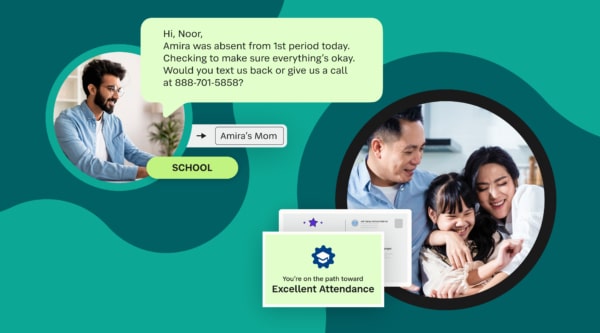

Family engagement is not just beneficial—it’s essential for student success. From elementary to high school, keeping families involved requires a strategic, evolving approach. Below, we share how to establish and nurture good engagement habits throughout the K-12 journey, focusing on easy-to-adopt tools and effective communication strategies.
The Foundation: Easy-to-Adopt Tools and Good Communication
Before diving into grade-specific strategies, let’s establish the core principles that should guide your family engagement efforts:
- User-Friendly Platforms: Implement communication tools that are intuitive for both staff and families. The easier the tool is to use, the more likely it is to be adopted.
- Consistent Onboarding: Develop a robust onboarding process for new families at each grade level. This sets expectations and teaches families how to engage effectively from day one.
- Multi-Channel Approach: Utilize a mix of communication channels (e.g., text, email, apps) to reach families where they are most comfortable.
- Personalization: Use data to tailor communications to individual student needs and family circumstances.
- 1:1 Communication: Prioritize personal interactions to build stronger relationships between educators and families.
Nurturing Engagement Habits Across Grade Levels
Elementary School: Building Strong Foundations
Early attendance patterns can predict chronic absence for the entire year. Moreover, by third grade, children who struggle with reading are four times more likely to drop out of high school. These facts underscore the critical nature of family engagement in elementary years.
Strategies:
- Welcoming Onboarding: Create a comprehensive “Welcome to School” packet that emphasizes the importance of attendance and family involvement. Include guides on using school-provided communication tools.
- Daily Check-ins: Implement a system for teachers to greet each student by name daily and share a positive note with families weekly.
- Interactive Reading Logs: Use a digital platform where families can log reading time and teachers can provide personalized feedback. For newcomer families, encourage and recognize reading aloud in their home language, highlighting the literacy benefits of this practice.
- Attendance Celebrations: Recognize good attendance through programs like “Punctual Pete” (a mascot that visits punctual classrooms) or “Club 96ers” (special recognition for students maintaining 96% attendance).
- Family Literacy Nights: Host inclusive events where families learn strategies to support reading at home, fostering a community of engaged learners. Provide materials and guidance in multiple languages to support diverse families.
Key Tip: Consistently communicate the long-term impact of early engagement habits. Help families understand how their involvement now shapes their child’s entire academic journey.
Middle School: Navigating the Transition
The transition to middle school can lead to decreased family involvement and increased risk of student disengagement.
Strategies:
- Transition Onboarding: Create a “Middle School 101” video series to help families understand new expectations and how to stay involved.
- Student-Led Conferences: Train students to lead family-teacher conferences, fostering responsibility and communication skills.
- Family-Teacher Texting Platform: Implement a secure communication platform for quick, direct messaging between families and teachers.
- Peer Mentoring Program: Pair new students with older peers, providing an additional support system and communication channel.
- Interest-Based Family Engagement: Offer diverse volunteer opportunities aligned with families’ skills and interests, making involvement more appealing.
Key Tip: Emphasize that while the nature of involvement changes, family engagement remains crucial for student success in middle school.
High School: Amplifying Student Voice and Combating Chronic Absenteeism
High school often sees higher levels of chronic absenteeism, necessitating a renewed focus on family engagement despite students’ increasing independence.
Strategies:
- Data-Driven Engagement: Use attendance and performance data to trigger personalized outreach to families, addressing issues proactively. Involve students in these conversations to promote ownership of their education.
- Student Success Teams: Form teams including teachers, counselors, families, and the student for those at risk of chronic absenteeism. Regular check-ins can be facilitated through video calls or in-person meetings, with students leading the discussion of their progress and goals.
- Career and College Readiness Updates: Send regular, personalized updates on students’ progress towards graduation and post-secondary goals, highlighting the impact of attendance on these goals. Encourage students to contribute to these updates, sharing their perspectives and aspirations.
- Student Influencer Program: Empower students with excellent attendance records to manage the school’s social media accounts. This program gives students a voice in school communications while promoting positive attendance habits.
- Flexible Family-Teacher Conferences: Offer virtual or off-hours conference options to accommodate working families’ schedules. Allow students to lead these conferences, presenting their work and discussing their progress.
Key Tip: Frame communication around students’ future success, helping families and students understand the long-term consequences of engagement and attendance decisions made in high school. Consistently provide opportunities for students to voice their opinions and take leadership roles in school-family communication.
Enhancing Belonging Through Communication
Across all grade levels, focus on these strategies to create a sense of belonging:
- Name Recognition: Train all staff to greet students by name. This simple act significantly boosts students’ sense of belonging.
- Personalized Achievements: Use your communication platform to send personalized messages celebrating individual student achievements, no matter how small.
- Cultural Responsiveness: Ensure communications are available in families’ preferred languages and respect cultural differences. Celebrate the diversity of your school community in your communications.
- Student Spotlight Series: Regularly feature student stories and achievements across your communication channels. Let students take the lead in creating and sharing these spotlights.
- Community Building Events: Host events that bring families, students, and staff together in informal settings to build relationships. Involve students in planning and running these events.
A Holistic Approach to Family Engagement
Effective family engagement is an ongoing process that should evolve as students progress through their academic journey. By focusing on easy-to-adopt tools, consistent communication, and strategies that enhance belonging and amplify student voices, schools can create a supportive environment that fosters student success at every level.
Remember, the goal is to create a partnership between schools and families that lasts from ABCs to SATs and beyond. With the right tools and strategies, you can build a community of engaged families that supports student achievement every step of the way.Are you ready to transform family engagement in your district? Explore how SchoolStatus can help you implement these strategies and more, creating a seamless communication experience that grows with your students from elementary to high school.
Stay Connected
News, articles, and tips for meeting your district’s goals—delivered to your inbox.





